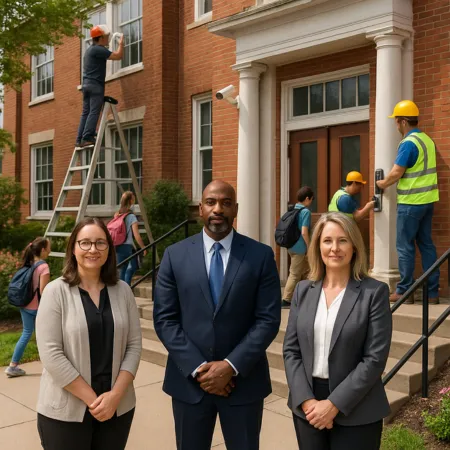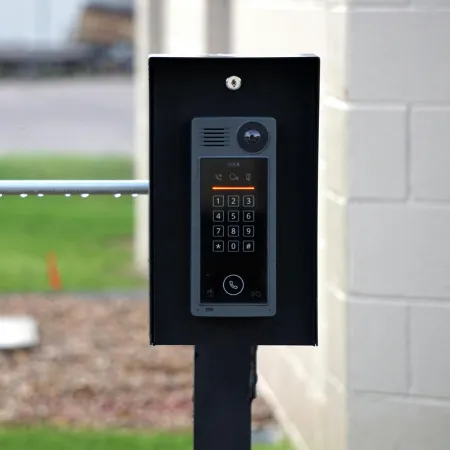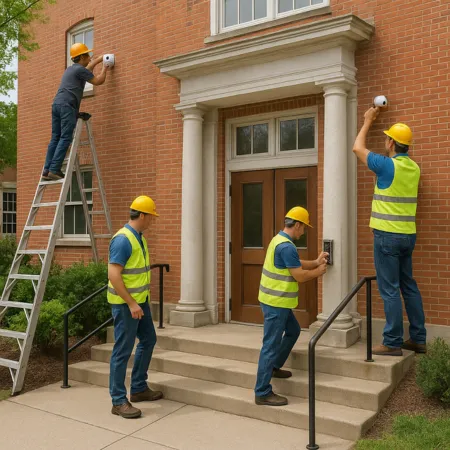Protecting Schools is Our Purpose!
Integrating Technology Into Comprehensive School Safety Plans

FSDAVCFEBFEVSDDVFSD

FSDAVCFEBFEVSDDVFSD

FSDAVCFEBFEVSDDVFSD
Modern Tools for Modern Threats
Why Tech Upgrades Are Essential Now

Locked doors and routine drills once defined campus security, but recent threats have shown how fast those layers can fail. In 2023 and 2024, national reports highlighted cases where intruders bypassed safety protocols through blind hallways, faulty intercoms, or unlocked doors. These events exposed how limited traditional methods are against evolving threats.
Outdated tools like paper binders or part-time monitors can’t keep up with modern risks. Schools now need faster identification, instant alerts, and systems that don’t rely solely on human reaction. Smart technology fills those gaps. AI cameras detect unusual activity, panic badges send silent signals, and dashboards show responders where help is needed.
These digital upgrades reduce delays and boost response time. In today’s environment, these tools are not enhancements—they’re essential. School safety now depends on systems that prevent, detect, and respond in moments.

Core Technologies to Consider in 2025
Artificial-intelligence cameras from the visual backbone of modern defence. Unlike legacy CCTV, these systems analyze motion, color, and behavioral patterns to spot loitering, brandished weapons, or crowd surges the instant they occur. Administrators receive mobile alerts with annotated still shots, letting them verify threats without leaving command posts. Recorded metadata also supports post-incident investigations and trend analysis, helping districts focus supervision and maintenance dollars where problems persist.
Access-control upgrades pair those cameras with smart credentials that timestamp every entry and allow remote lockdown by zone. Teachers tap a badge rather than fumble with keys, while expired visitor passes automatically disable themselves at checkout. Because controllers store events in the cloud, facility managers can audit door activity from any device, cross-referencing openings against video clips to detect tailgating, stolen cards, or doors left ajar.
Environmental sensors add a third protection layer. Vape detectors in schools sample air for nicotine and THC, notifying deans before hallways haze over. Gunshot-detection microphones triangulate blasts and trigger automated announcements, while co-located air-quality probes monitor CO2 and temperature to support wellness goals. A unified mass notification platform then collates all sensor, video, and access data, pushing concise instructions via intercoms, SMS, and classroom displays within moments.
Smart Funding and Grant Tactics

Federal programs such as STOP School Violence and COPS SVPP allocate millions yearly for hardware, software, and training. Districts increase success rates by pairing incident statistics with specific technology requests, showing reviewers a line between past vulnerabilities and the proposed camera, badge, or sensor upgrade.
Combining multiple campuses into one application amplifies impact metrics while reducing administrative overhead. Applicants should attach letters of support from police, fire, and community coalitions to demonstrate regional collaboration.
Cost-sharing clauses, even small ones, signal fiscal responsibility and can nudge scores above the funding threshold.
Districts lacking capital can shift expenses to operating budgets through software-as-a-service subscriptions or managed-service models. These arrangements bundle licensing, updates, and repairs into predictable monthly fees, avoiding large upfront purchases. Finance officers can showcase cash-flow neutrality, a persuasive argument for boards cautious about long-term debt.
Federal programs such as STOP School Violence and COPS SVPP allocate millions yearly for hardware, software, and training. Districts increase success rates by pairing incident statistics with specific technology requests, showing reviewers a line between past vulnerabilities and the proposed camera, badge, or sensor upgrade.
Combining multiple campuses into one application amplifies impact metrics while reducing administrative overhead. Applicants should attach letters of support from police, fire, and community coalitions to demonstrate regional collaboration.
Cost-sharing clauses, even small ones, signal fiscal responsibility and can nudge scores above the funding threshold.
Districts lacking capital can shift expenses to operating budgets through software-as-a-service subscriptions or managed-service models. These arrangements bundle licensing, updates, and repairs into predictable monthly fees, avoiding large upfront purchases. Finance officers can showcase cash-flow neutrality, a persuasive argument for boards cautious about long-term debt.

Before drafting any proposal, safety leaders should conduct a needs assessment that inventories existing hardware, recent incident logs, and staff perception surveys. Quantifying gaps allows writers to translate qualitative concerns into numeric baselines—door propping occurrences per week, average radio response times, or percentage of classrooms without visual coverage. These figures become measurable outcomes for grant evaluators and later serve as performance benchmarks when districts submit mid-year or final reports to show progress and justify renewals.
Creating a community advisory board further strengthens the narrative. Representatives from parent-teacher groups, student councils, local health agencies, and neighborhood associations lend diverse perspectives and provide channels for transparent communication. During budget hearings or bond campaigns, these champions testify to the plan’s legitimacy, diffusing skepticism and spreading ownership. Their involvement also supports sustainability claims because training schedules, technology refresh cycles, and policy updates are reviewed in an open forum rather than behind administrative doors alone.
Protecting Privacy While Staying Effective
Parents rightfully demand robust privacy protections when new surveillance tools arrive. Districts should start by mapping every data flow—camera feeds, badge metadata, sensor alerts—and labeling which systems store personally identifiable information. Privacy impact assessments clarify where encryption, role-based access, or data-sharing agreements are required. Publishing the summary assessment on the district website demonstrates accountability and prevents rumors before they spiral on social media or community forums channels.
Video retention policies balance investigative value with civil liberties. Best practice keeps full-resolution footage for thirty days, then archives low-resolution snapshots for trend analysis. Cameras covering sensitive areas such as counseling offices should mask doorways rather than interiors. Vape detectors log chemical signatures but not student identities unless paired with badge scans, reducing disciplinary bias claims while still allowing administrators to pinpoint problem halls for supervision.
Districts must also craft opt-out procedures that respect family choices without diluting overall security. A practical model permits parents to withhold a student’s likeness from external media releases yet still allows internal monitoring during emergencies. Annual consent forms, explained during registration, improve compliance rates and minimize day-of-crisis confusion. Finally, data-sharing MOUs with law enforcement should specify access limits, audit trails, and destruction timelines for all retained records.
Training Staff and Students Effectively
Technology gains value only when end users understand it. A pilot program should begin with one hallway or grade level, allowing IT teams to observe glitches before campus rollout. Early adopters then mentor peers, easing anxiety and reducing help-desk tickets when the wider deployment starts.
Micro-learning modules hosted in the district LMS cover single tasks—activating a panic badge, muting a classroom display—so substitutes can review on demand. Pair digital lessons with live drills that simulate sensor alerts and real-time announcements, reinforcing muscle memory and revealing procedural gaps under mild stress.
Backup plans matter. Each classroom should store paper route cards and a whistle in case power or networks fail. Bus drivers receive laminated cheat sheets with radio codes and contact numbers. Inclusion of low-tech workarounds prevents single-point failures and reminds teams that tech supports, never replaces judgment.

Schedule quarterly refresher sessions that pair technology updates with tabletop scenarios. For example, after firmware adds automatic door-locking rules, present a hypothetical intruder at the gym entrance and ask teams to walk through alert initiation, broadcast scripting, and lockdown release. Including first responders in these sessions confirms interoperability and uncovers radio dead zones or mapping errors before an actual call. Attendance rosters provide documentation for insurance audits and satisfy many state professional-development mandates for staff.
Classrooms require concise quick-reference guides. Laminate one-page flowcharts that outline alarm sounds, badge colors, and evacuation arrows specific to each building wing. Post them beside light switches, and email a digital copy at the semester’s start and after any change. Teachers can consult them within seconds rather than searching intranet folders mid-crisis. Include QR codes linking to the latest video tutorials so new staff and volunteers assimilate procedures with minimal disruption or costly orientation delays.
Tracking Results and Adapting Over Time
Success begins with metrics. Start by logging every emergency alert, drill, and device malfunction in a spreadsheet or ticketing system. Calculate average alert delivery time, percentage of classrooms receiving audio and visual messages, and duration from first notification to all-clear. Graphing these numbers each quarter reveals upward or downward trends that can reinforce presentations and indicate whether training, firmware patches, or hardware replacements are the next priority.
Device health dashboards from camera and access-control vendors often include uptime statistics, network latency, and firmware status. Export this information monthly and merge it with help-desk logs to spot chronically failing doors or cameras, then schedule preventive maintenance before a critical incident. Showing year-over-year reductions in downtime bolsters future grant renewals and signals taxpayers that capital investments are being protected through proactive asset management and budgetary transparency.
Feedback loops close the improvement cycle. Survey teachers after each drill about clarity of instructions, badge ergonomics, and perceived response speed; offer an anonymous form so critiques are candid. Present summarized findings to student councils and parent committees, inviting suggestions that may refine message phrasing or speaker placement. Publishing the action plan that follows each survey keeps stakeholders engaged and demonstrates that their voices influence investments.
Have Questions About What We Offer?
To learn more about our services, contact us today!
Have Questions About What We Offer?
Contact us to learn more about our services
Quick Links
Hours of Operation
Mon - Fri | 9:00 AM - 5:00 PM
Sat - Sun | Closed

©2025 American Priority Project | All Rights Reserved | Privacy Policy

